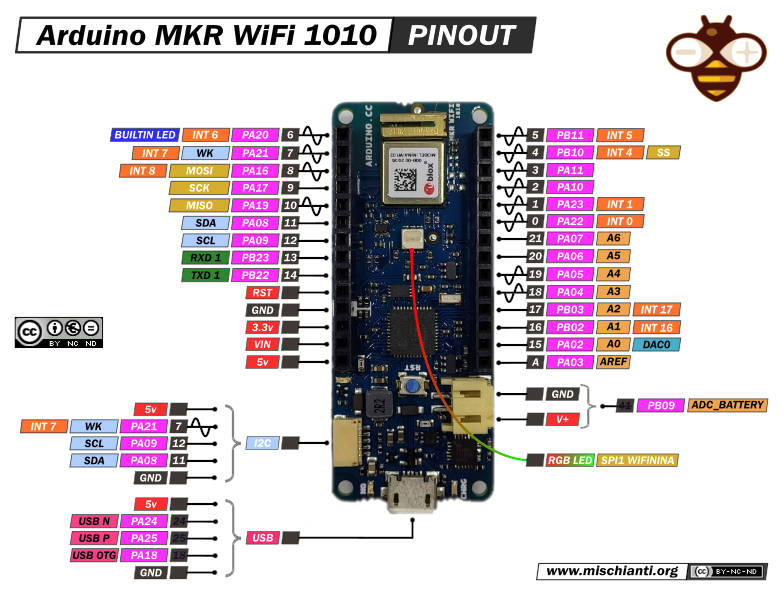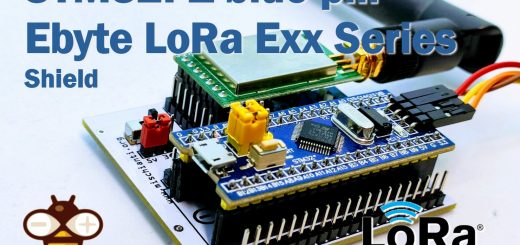Arduino MKR WiFi 1010 high resolution pinout and specs
Link to the high resolution pinout image.
You can find here Amazon Arduino MKR WiFi 1010
Main chip
- CPU and Memory
- ARM® Cortex®-M0+ CPU ATSAMD21G18A running at up to 48 MHz
- Single-cycle hardware multiplier
- Micro Trace Buffer (MTB)
- 256 KB in-system self-programmable Flash
- 32 KB SRAM Memory
- System
- Power-on Reset (POR) and Brown-out Detection (BOD)
- Internal clock 32.768 kHz (RTC), 48 MHz
- 16 external interrupts
- Two-pin Serial Wire Debug (SWD) programming, test and debugging interface
- Low Power
- Idle and Stand-by Sleep modes
- SleepWalking peripherals
- Peripherals
- 12-channel Direct Memory Access Controller (DMAC)
- 12-channel Event System
- 32-bit Real Time Counter (RTC) with clock/calendar function
- CRC-32 generator
- 1 × full-speed USB OTG
- Up to six Serial Communication Interfaces (SERCOM), each configurable for various protocol.
- One two-channel Inter-IC Sound (I2S) interface
- One 12-bit, 350ksps Analog-to-Digital Converter (ADC) with up to 20 channels
- 10-bit, 350 ksps Digital-to-Analog Converter (DAC)
- Peripheral Touch Controller (PTC)
- 256-Channel capacitive touch and proximity sensing
- PWM Pins: 12 (0, 1, 2, 3, 4, 5, 6, 7, 8, 10, A3 – or 18 -, A4 -or 19)
- UART: 1
- SPI: 1
- I2C: 1
- I2S: 1
- Connectivity: WiFi
- Analog Input Pins: 7 (ADC 8/10/12 bit)
- Analog Output Pins: 1 (DAC 10 bit)
- External Interrupts: 8 (0, 1, 4, 5, 6, 7, 8, A1 -or 16-, A2 – or 17)
- LED_BUILTIN: 6
Radio NINA-W10 Specs
The WiFi/Bluetooth module is controlled via the secondary SPI include a dual-core system with two Harvard Architecture Xtensa LX6 CPUs operating at a maximum 240 MHz internal clock frequency (an esp32).
- Processor memory
- 448 Kbyte ROM for booting and core functions
- 520 Kbyte SRAM for data and instruction
- 16/32 (NINA-W101 and NINA-W102/NINA-W106) Mbit FLASH for code storage, including
- hardware encryption to protect programs.
- 1 kbit EFUSE (non-erasable memory) for MAC addresses, module configuration, flash encryption, and chip ID
- Wi-Fi
- IEEE 802.11b/g/n
- Output power: 15 dBm
- Data rates max: 72 Mbit/s
- Bluetooth BR/EDR
- Bluetooth v4.2 + EDR (Maximum number of slaves: 7)
- Band support: 2.4 GHz, 79 channels (40 channels for low energy)
- Output power/data rates: 1/2/3 Mbit/s: 5 dBm (1Mbps 5 dbm for low energy)
Security and cryptography
The security is granted by microchip ATECC508A
- Cryptographic Co-processor with Secure Hardware-Based Key Storage
- Performs High-Speed Public Key (PKI) Algorithms
- ECDSA: FIPS186-3 Elliptic Curve Digital Signature Algorithm
- ECDH: FIPS SP800-56A Elliptic Curve Diffie-Hellman Algorithm
- NIST Standard P256 Elliptic Curve Support
- SHA-256 Hash Algorithm with HMAC Option
- Host and Client Operations
- 256-bit Key Length
- Storage for up to 16 Keys
- Two High-Endurance Monotonic Counters
- Guaranteed Unique 72-bit Serial Number
- Internal High-Quality FIPS Random Number Generator (RNG)
- 10 Kb EEPROM Memory for Keys, Certificates, and Data
- Multiple Options for Consumption Logging and One-Time Write Information
- Intrusion Latch for External Tamper Switch or Power-on Chip Enablement.
How to
Datasheet
SAMD21
NINA-W102
ATECC508
Thanks
- Arduino
- esp8285
- esp8266
- ESP32
- DOIT ESP32 DEV KIT v1
- ESP32 DevKitC v4
- ESP32 WeMos LOLIN32
- ESP32 WeMos LOLIN32 Lite
- ESP32 WeMos LOLIN D32
- ESP32-wroom-32
- NodeMCU-32S
- ESP32-S
- ESP32-CAM
- ESP32-2432S028 (Cheap Yellow Display)
- ESP32-2432S032 (Cheap Yellow Display)
- ESP32 s2
- ESP32c3
- ESP32s3
- Arduino SAMD
- STM32
- Raspberry Pi













Hi, you mention that the mkr wifi 1010 has “256-Channel capacitive touch and proximity sensing”.
I can´t find information about this elsewhere, and I wonder if any of the pins actually have capacitive touch capability and how I would use it.
On a huzzah32 it is easy using the touchRead() function, but I guess that is specific to esp32.
Hi Gilje,
I don’t test that feature, but I’m sure that It’s a spec of SAMD21, I think you can use this Adafruit_FreeTouch library, exist also another library LibrePTC that is suitable for SAMD11 but seems It work with SAMD21.
If you try It give me a feedback.
Bye Renzo